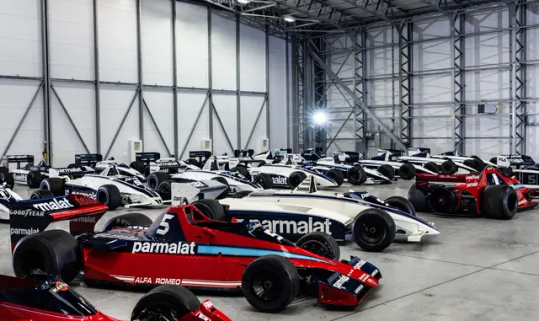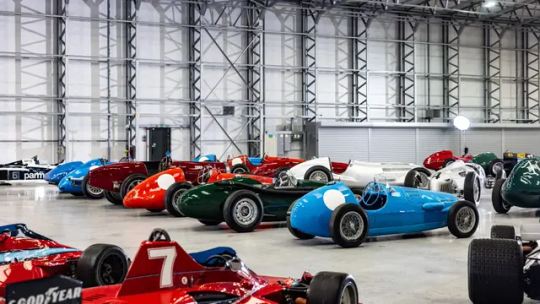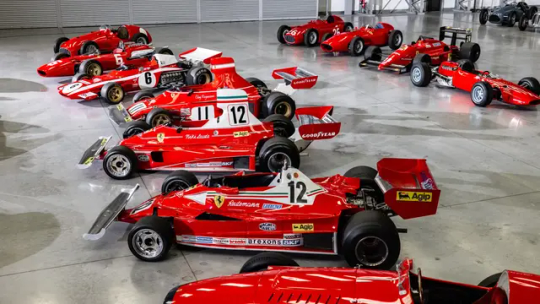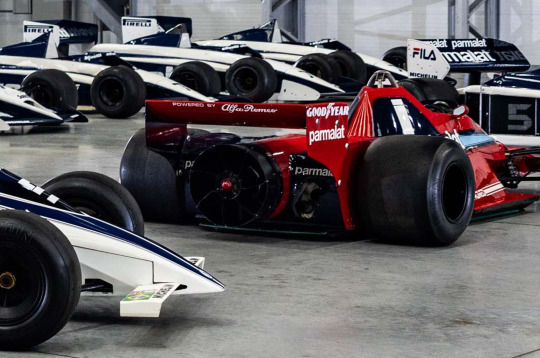#thinwall special
Explore tagged Tumblr posts
Text







Bernie Ecclestone's collection of historic grand prix and Formula 1
Mr Ecclestone, 94, is now parting ways with many of them—a total of 69 cars—which will be sold via U.K. exotic car specialist Tom Hartley Jr.
Many of them have been locked away for decades, as Ecclestone rarely showed them to the public, if at all.
The crown jewels of Ecclestone’s collection include some of the most iconic machines in racing history:
José Froilán González’s Ferrari 375: The 1951 Italian Grand Prix winner that marked Ferrari’s first F1 victory.
Mike Hawthorn’s 1958 Dino: Driven by the first British Formula 1 World Champion.
Michael Schumacher’s Ferrari F2002: A car that dominated the 2002 season with 15 wins.
Ferrari 312B3: The team’s first true monocoque chassis.
Carlos Reutemann’s 1977 Brazilian GP-winning chassis.
1993 McLaren MP4/8A F1 race car piloted by Ayrton Senna
The collection also features other historic rarities, including the Thinwall Special, further cementing its status as one of motorsport’s greatest treasure troves.
This isn’t the first time Ecclestone has let go of prized automobiles. The former F1 boss previously sold over 50 cars during RM Sotheby’s infamous auction, but this sale represents a deeper emotional moment. These cars embody not only his love for motorsport but also his unparalleled contribution to Formula 1’s history.
The sale will occur through a private treaty process, meaning the prices of individual cars will not be disclosed. However, with an estimated collective value of $634 million, collectors and institutions worldwide are expected to vie for a piece of Ecclestone’s extraordinary legacy.
#art#design#luxury cars#luxury lifestyle#billioinairelife#billionaire#collection#sportacrs#sportcar#supercars#supercar#hypercars#hypercar#formula 1#race cars#race car#ferrari#thinwall special#history#auction#bernie ecclestone#dino#michael schumacher#ayrton senna
65 notes
·
View notes
Video
youtube
Ed's Incredible '63 IMPALA
The 1963 Impala featured rectilinear styling with an engine-turned aluminum rear taillight panel surrounded by a chrome border on SS models. Engine choice was similar to 1962, with the small-block 283 cu in (4.6 L) and 327 cu in (5.4 L) V8s most popular. The Stovebolt six-cylinder engine was replaced with a new 230 cu in (3.8 L) Turbo-Thrift six that used thinwall castings and would continue as the standard engine for Chevrolet cars through 1979. The Sport Sedan featured a new, creased roof line. A new "coved" instrument panel included simple indicator lights for hot and cold engine conditions. An optional factory tachometer was built into the dashboard, just above the steering wheel. Impala wagons got triple-unit taillights for the first time.
A special 427 cu in (7.0 L) version of the 409 cu in (6.7 L) engine was used in the 1963 Chevrolet Impala Sport Coupe, ordered under Chevrolet Regular Production Option (RPO) Z11. This was a special package created for drag racers and NASCAR and included a 427 with aluminum body parts and a cowl-induction air intake system. The aluminum body parts were fabricated in Flint, Michigan at the facility now known as GM Flint Metal Center. Unlike the later second-generation 427, it was based on the W-series 409 engine, but with a longer 3.65 in (93 mm) stroke. A high-rise, two-piece aluminum intake manifold and dual Carter AFB carburetors fed a 13.5:1 compression ratio to produce 430 horsepower (320 kW) and 575 lb⋅ft (780 N⋅m) of torque. Fifty RPO Z11 cars were produced at the Flint GM plant.
#impalalowrider #lowrider #impala #classiccar #americancar #customcar #hotrod #kustom #ratrod #vintagecar #oldschool #carporn #carlifestyle #carculture #automotive #motorhead #petrolhead #gearhead #carguy #cargirl
0 notes
Photo

FERRARI 375 Thinwall Special F1 race car 2x large photos at Winfield 1951 Click Here Now To Bid
0 notes
Text
The Original Vanwall British Grand Prix Winning Car Returns To Sefton
THIS YEAR MARKS THE 60TH ANNIVERSARY of the famous win by Sir Stirling Moss and Tony Brooks at the British Grand Prix at Aintree, which also had the prestige of being the Grand Prix D’Europe for 1957. The Vanwall Grand Prix car made motor racing history and was the last hurrah of the soon-to-be obsolete front engine Grand Prix cars as it scooped the first ever constructor’s World Championship. A special celebration event is being held at The Atkinson, Southport’s beautiful home for music, theatre, art, poetry, literature and history, right in the middle of Lord Street in Southport, on Thursday 13 July to celebrate Sefton’s sporting heritage and to fundraise for The Atkinson Development Trust, which works with the collection to help families, schools and the community access the arts. With its new ‘teardrop’ design and guest driver Stirling Moss (pictured below in the Vanwall) aka ‘The Boy’ as he was affectionately known, the Vanwall drove to victory at a time when the red of Italy dominated Formula 1 racing. What started out as a hobby of the hypercompetitive millionaire, British Industrialist, Mr Anthony Vandervell developed into a life’s obsession. As an early backer of the BRM V16 Grand Prix Car he quit and embarked on his own team so he could have sole control. The name Vanwall was an amalgamation of Vandervell and Thinwall [Thinwall Bearings were Vandervell’s Company’s best known product]. The first Vanwall Special was built for the new Formula 1 regulations for 1954. The Vanwall engine consisted of four 500 cc Norton engines combined into one 2-litre unit. The engine was designed by Norton engineer Leo Kuzmicki. Vandervell was able to use Norton engines and expertise due to the fact that his father was Chairman of Norton! At the end of 1955, Vandervell commissioned a young aircraft engineer, Frank Costin, to design a new sleek, aerodynamic body shape for the Vanwall and Colin Chapman (Lotus) to design the chassis. This resulted in an immediate success as Stirling Moss won the 1956 International Trophy at Silverstone in May. 150,000 people are estimated to have been spectators at Aintree in 1957 as the now three-car Vanwall team took on the power of Lancia-Ferrari and Maserati. After Moss qualified on pole, on lap 27 he had car failure and with Brooks still bandaged from his crash at Le Mans, he brought in his sister car and handed over to Moss – who re-joined the race and won at our home Grand Prix for an unprecedented win!

This was the first World Championship win for a British car and Moss and Brooks were the first British drivers to win the British Grand Prix in a British Car. The Vanwall’s history may have been short-lived but it had paved the way for other British constructors to challenge and beat the best of the continental powers. The Vanwall historic motor racing car will take pride of place in The Atkinson foyer for 2 weeks from 7-17 July thanks for the generosity of our sponsors AJEstate Agents, Fletchers Solicitors and Stubbs Parkin Chartered Accountants. They have made it possible to have the Vanwall in Sefton for this time and during the British Grand Prix Weekend, which will make it extra special for motoring fans. Emma Anderson, Director The Atkinson said: “We would like to say a huge thankyou to the Donington Museum for lending us the Vanwall and to Peter Cowley and John Searle who have worked so hard with us to make this piece of history come to life.” __________ from p. 4 of issue June 2017 Subscribe now - www.classicmotor.co.uk
#classic#motor#monthly#cmm#autojumbler#publication#vanwall#world#championship#british#moss#brooks#grand#prix#museum#donington#sefton#aintree
0 notes
Video
youtube
Aspen Green - Leo’s Award Winner
The 1963 Impala featured rectilinear styling with an engine-turned aluminum rear taillight panel surrounded by a chrome border on SS models. Engine choice was similar to 1962, with the small-block 283 cu in (4.6 L) and 327 cu in (5.4 L) V8s most popular. The Stovebolt six-cylinder engine was replaced with a new 230 cu in (3.8 L) Turbo-Thrift six that used thinwall castings and would continue as the standard engine for Chevrolet cars through 1979. The Sport Sedan featured a new, creased roof line. A new "coved" instrument panel included simple indicator lights for hot and cold engine conditions. An optional factory tachometer was built into the dashboard, just above the steering wheel. Impala wagons got triple-unit taillights for the first time.
A special 427 cu in (7.0 L) version of the 409 cu in (6.7 L) engine was used in the 1963 Chevrolet Impala Sport Coupe, ordered under Chevrolet Regular Production Option (RPO) Z11. This was a special package created for drag racers and NASCAR and included a 427 with aluminum body parts and a cowl-induction air intake system. The aluminum body parts were fabricated in Flint, Michigan at the facility now known as GM Flint Metal Center. Unlike the later second-generation 427, it was based on the W-series 409 engine, but with a longer 3.65 in (93 mm) stroke. A high-rise, two-piece aluminum intake manifold and dual Carter AFB carburetors fed a 13.5:1 compression ratio to produce 430 horsepower (320 kW) and 575 lb⋅ft (780 N⋅m) of torque. Fifty RPO Z11 cars were produced at the Flint GM plant.
#lowrider #lowriders #lowridercars #lowridershow #lowriding #lowrider #impalalowrider #lowrideroldies #lowridershopping #lowridermagazine #cadillaclowrider #fleetwood #carcruise #autosuper #carculture #cruisenight #carshow #carmeet #cruising #chevrolet #hydraulics #classiccars #car #cars #ragtop
0 notes